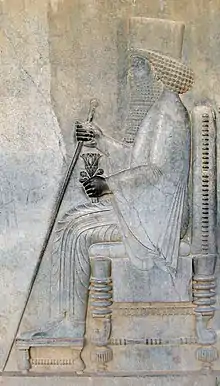Arbinas
Arbinas, also Erbinas, Erbbina, was a Lycian Dynast who ruled circa 430/20-400 BCE. He is most famous for his tomb, the Nereid Monument, now on display in the British Museum.[1] Coinage seems to indicate that he ruled in the western part of Lycia, around Telmessos, while his tomb was established in Xanthos.[2] He was a subject of the Achaemenid Empire.[3]
Arbinas | |
|---|---|
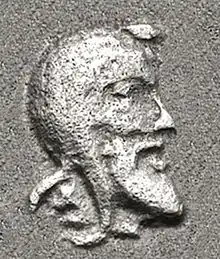 Portrait of Arbinas wearing the satrapal headdress, from his coinage. | |
| Native name | Erbinas |
| Allegiance | |
| Rank | Satrap |
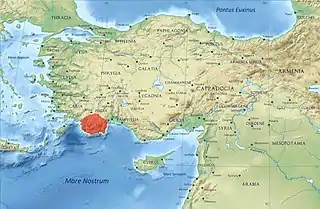
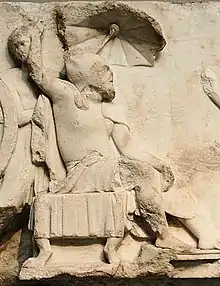
Rule
He was the son of the previous Lycian king Kheriga.[4] On his inscriptions, Erbinas is described as a tyrannos, and "the man who rules over the Lycians".[4]
It seems the Lycia kingdom started to disintegrate during the rule of Arbinas, as numerous smaller rulers started to mint coinage throughout Lycia during his reign and after.[3]
Tomb
His monumental tomb, the Nereid Monument, now in the British Museum, was the main inspiration for the famous Mausoleum at Halicarnassus.[5] Using the design of a Greek Temple for the building of a tomb was unheard of in mainland Greece.
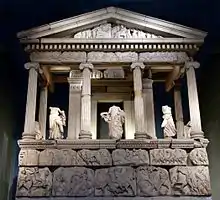 The Nereid Monument is thought to be the tomb of Arbinas. British Museum.
The Nereid Monument is thought to be the tomb of Arbinas. British Museum. Reconstitution of the original tomb of Erbinas.
Reconstitution of the original tomb of Erbinas. Arbinas portrait, with Persian cap. Nereid Monument.
Arbinas portrait, with Persian cap. Nereid Monument.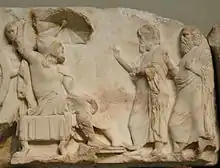 Arbinas, in Persian dress, receives emissaries. Nereid Monument.
Arbinas, in Persian dress, receives emissaries. Nereid Monument.
Coinage
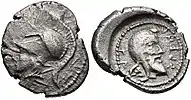 Coin of King Arbinas, wearing the Persian cap on the reverse. Circa 430/20-400 BC
Coin of King Arbinas, wearing the Persian cap on the reverse. Circa 430/20-400 BC Coin of King Arbinas. Athena and Herakles on each side. Circa 430/20-400 BC
Coin of King Arbinas. Athena and Herakles on each side. Circa 430/20-400 BC Coin of King Arbinas. Athena and Herakles.
Coin of King Arbinas. Athena and Herakles.
References
- Keen, Antony G. (1998). Dynastic Lycia: A Political of History of the Lycians and Their Relations with Foreign Powers : C. 545-362 B.C. BRILL. p. 145. ISBN 9004109560.
- Keen, Antony G. (1998). Dynastic Lycia: A Political of History of the Lycians and Their Relations with Foreign Powers : C. 545-362 B.C. BRILL. p. 146. ISBN 9004109560.
- Fried, Lisbeth S. (2004). The Priest and the Great King: Temple-palace Relations in the Persian Empire. Eisenbrauns. p. 150. ISBN 9781575060903.
- Keen, Antony G. (1998). Dynastic Lycia: A Political of History of the Lycians and Their Relations with Foreign Powers : C. 545-362 B.C. BRILL. p. 47. ISBN 9004109560.
- André-Salvini, Béatrice (2005). Forgotten Empire: The World of Ancient Persia. University of California Press. p. 46. ISBN 9780520247314.
